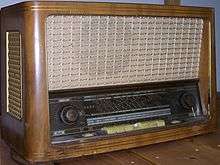SABA (electronics manufacturer)

SABA (Schwarzwälder Apparate-Bau-Anstalt) is a German electronics company founded in 1923 at Triberg im Schwarzwald (Black Forest), present-day Baden-Württemberg. SABA started as a clock-making company, then became a radio manufacturer, and a few years later a record label. In 1968, SABA sold the majority of the company to GTE, an American telephone company. In 1980 the company was purchased by Thomson SA and integrated as a separate business unit.
History
SABA began as a clock-maker in Triberg (Black Forest), founded in 1835 by Benedikt Schwer. In 1918 it moved to Villingen. Herman Schwer, the founder's grandson, started the manufacturing of headphones, radio parts, and a variety of products from radio components to receivers.
In 1931, SABA produced more than 100,000 units of the SABA Radio Type S-35. It introduced for the first time on the market dynamic loudspeakers which became soon a bestseller. The company developed the first radio receiver with search and automatic fine tuning in all bandwidths. In 1951 IFA, a consumer industry electronics show in Berlin allowed SABA to show the first TV receiver to the world. SABA successes enabled the company to manufacture tape recorders. It introduced the large TV screen projector 'Telerama' on the market. And it launched the first color TV with wireless remote control.
Purchase
In 1968 the American Company GTE purchased 85% of SABA. SABA built the first hi-fi audio set with wireless remote control and introduced a failure diagnosis system. SABA launched first modularized color TV built only of pluggable sub-assembly boards. In 1976 SABA became a subsidiary of the American company GTE. In 1980 GTE left consumer electronic distribution. Thomson-Brandt, a consumer electronics group with headquarters in Paris, purchased SABA manufacturing and distribution. The brand became one of the market leaders in video and created the first German video training school. Ten years later SABA launched the first portable LCD television.
SABA launched several products designed by Philippe Starck, the director of consumer electronics at Thomson. These included: "Jim Nature" (1994), a portable TV set made of recycled high-density wood, now exhibited in the Museum of Modern Art (MoMA) in New York City, and "Oye-Oye", a small radio with an innovative form factor.
Record label
Saba had a record label founded by Hans Georg Brunner-Schwer, grandson of the electronics company's founder, to produce music for automobile tape players. In 1967 Saba's catalogue included Oscar Peterson, Nathan Davis, and the Clarke-Boland Big Band. Saba bought distribution rights from Prestige Records. Saba's parent company was bought by an American company that discontinued the recording operation. Brunner-Schwer then established MPS Records.[1]
References
| Wikimedia Commons has media related to SABA (electronics manufacturer). |